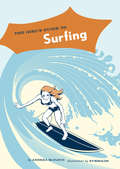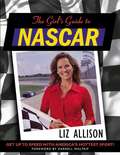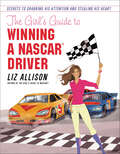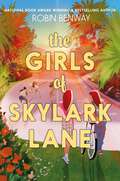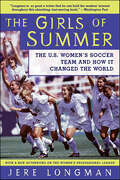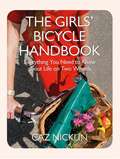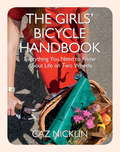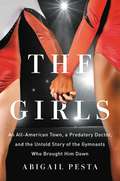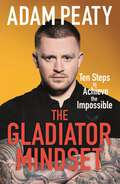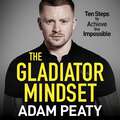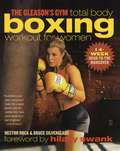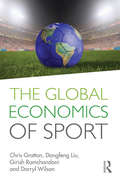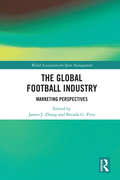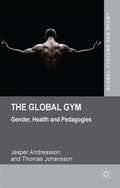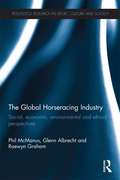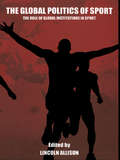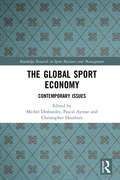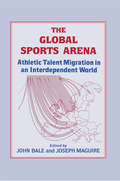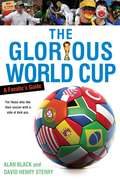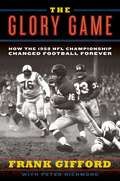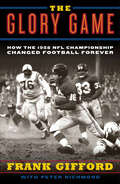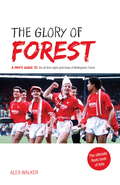- Table View
- List View
The Girl's Guide to Surfing
by Andrea Mccloud SymbolonThe Girl's Guide to Surfing delivers all a girl needs to score the wave of her choice. The surfing population has recently exploded, and women are in the water more than ever. For all these hearty souls, author Andrea McCloud delivers down-to-earth instruction and indispensable advice. Find out what kind of surf equipment is specifically right for women and how to get it. Learn how to read local breaks and tides for catching the right wave at the right spot. Get the lowdown on surf etiquette to avoid getting yelled at, or worse, crashing into someone. And hear war stories from the pros about how they learned to surf, how they conquer fear, and what it's like to pull into a fat tube. Featuring loads of informative illustrations, sidebars, and tips, The Girl's Guide to Surfing is the bible for any girl who wants to catch a wave.
The Girl's Guide to Winning a NASCAR(R) Driver: Secrets to Grabbing His Attention and Stealing His Heart
by Liz AllisonHow do you marry a NASCAR driver? In a professional sport where over half its athletes are single men, no one but Liz Allison would, let alone could, dare to answer. Tongue-in-cheek but cunningly insightful, this satirical relationship guidebook with a NASCAR twist that will rev any female NASCAR fan's engine.
The Girl's Guide to Winning a NASCAR(R) Driver: Secrets to Grabbing His Attention and Stealing His Heart
by Liz Allison"How do you marry a NASCAR driver?" In a professional sport where over half its athletes are single men, no one but Liz Allison would, let alone could, dare to answer. Tongue-in-cheek but cunningly insightful, this satirical relationship guidebook with a NASCAR twist that will rev any female NASCAR fan's engine.
The Girls Strike Back: The Making of the Pink Parrots (Pink Parrots #1)
by Lucy EllisLed by Amy "Breezy" Hawk, a group of seventh grade girls form their own all-girl baseball team in protest of the discriminatory practices of the local baseball league.
The Girls of Skylark Lane
by Robin Benway"In this heartwarming slice-of-life novel, a middle grade debut, Benway (The Wicked Ones) showcases the importance of friendship, family, and forgiveness in helping tweens navigate the awkwardness and uncertainty of early adolescence." —Publishers Weekly (starred review)"Benway weaves themes of teamwork, solidarity, gender equity, and empowerment throughout.... A heartwarming, richly told coming-of-age story that radiates humor and care." —Kirkus Reviews (starred review)National Book Award winner Robin Benway debuts a coming-of-age middle grade novel about friendships, family, and discovering the person you’re meant to be. Babysitters Club meets The Sandlot when twin sisters join a ragtag neighborhood girls softball team at a time when growing up could mean growing apart. Aggie and Jac might be twin sisters, but lately they haven’t felt the same about anything. While Jac is excited about their move to Los Angeles and a chance to seem cool and mysterious, Aggie is worried her new locker won’t open, that Jac could make new friends without her, and that her friends from home will move on, leaving her all alone.When the first day at school ends with an invite to join the neighborhood softball team, Aggie jumps at the chance to meet the other girls, even if she has to drag along Jac, whose own interest in the softball team might have more to do with the captain’s older brother… Aggie is relieved to learn that each girl is dealing with their own problems and becomes excited at the opportunity to create strong friendships. But as Jac and Aggie grow into different people, will they be able to hold on to their sisterhood? For life throws the biggest curveball of all: growing up.
The Girls of Summer: The U.S. Women's Soccer Team and How It Changed the World
by Jere LongmanNow with a new afterword, The Girls of Summer, by the award- winning New York Times sportswriter Jere Longman, takes a serious, compelling look at the women who won the 1999 World Cup and brings to life the skills and victories of the American team. Longman explores the issues this unprecedented achievement has raised: the importance of the players as role models; the significance of race and class; the sexualization of the team members; and the differences between men and women's sports. Provocative and insightful, this book reminds us that the real struggles are off the field -- and some remain to be won.
The Girls' Bicycle Handbook
by Caz NicklinThe Girls' Bicycle Handbook is for women cyclists everywhere who need practical no-nonsense advice and information on cycling, but don't want to dispense with style in the process.Whether you're a committed bike commuter or a complete novice, blogger, entrepreneur and passionate cyclist Caz Nicklin gives the low-down on making cycling part of your lifestyle. From choosing the right bike for your needs to looking stylish and comfortable whatever the weather, and from combatting dreaded "helmet hair" to road safety and fast repairs, The Girls' Bicycle Handbook tells you everything you need to know about life on two wheels.
The Girls' Bicycle Handbook: Everything You Need to Know About Life on Two Wheels
by Caz NicklinThe Girls' Bicycle Handbook is for women cyclists everywhere who need practical no-nonsense advice and information on cycling, and cycling in style. Whether you're a committed bike commuter or a complete novice, cycling entrepreneur and blogger Caz Nicklin gives the low-down on making cycling part of your lifestyle. From choosing the right bike for your needs to looking stylish and comfortable whatever the weather, and from combatting 'helmet hair' to road safety and fast repairs, The Girls' Bicycle Handbook tells you everything you need to know about life on two wheels.
The Girls' Bicycle Handbook: Everything You Need to Know About Life on Two Wheels
by Caz NicklinThe Girls' Bicycle Handbook is for women cyclists everywhere who need practical no-nonsense advice and information on cycling, and cycling in style. Whether you're a committed bike commuter or a complete novice, cycling entrepreneur and blogger Caz Nicklin gives the low-down on making cycling part of your lifestyle. From choosing the right bike for your needs to looking stylish and comfortable whatever the weather, and from combatting 'helmet hair' to road safety and fast repairs, The Girls' Bicycle Handbook tells you everything you need to know about life on two wheels.
The Girls: An All-American Town, a Predatory Doctor, and the Untold Story of the Gymnasts Who Brought Him Down
by Abigail PestaThe inside story of how serial predator Larry Nassar got away with abusing hundreds of gymnasts for decades -- and how a team of brave women banded together to bring him down.We think of Larry Nassar as the despicable sexual predator of Olympic gymnasts -- but there is an astonishing, untold story. For decades, in a small-town gym in Michigan, he honed his manipulations on generations of aspiring gymnasts. Kids from the neighborhood. Girls with hopes of a college scholarship. Athletes and parents with a dream. In The Girls, these brave women for the first time describe Nassar's increasingly bold predations through the years, recount their warning calls unheeded, and demonstrate their resiliency in the face of a nightmare. The Girls is a profound exploration of trust, ambition, betrayal, and self-discovery. Award-winning journalist Abigail Pesta unveils this deeply reported narrative at a time when the nation is wrestling with the implications of the MeToo movement. How do the women who grew up with Nassar reconcile the monster in the news with the man they once trusted? In The Girls, we learn that their answers to that wrenching question are as rich, insightful, and varied as the human experience itself. p.p1 {margin: 0.0px 0.0px 0.0px 0.0px; font: 12.0px 'Times New Roman'} p.p2 {margin: 0.0px 0.0px 0.0px 0.0px; font: 12.0px 'Times New Roman'; color: #323333; min-height: 15.0px}
The Gladiator Mindset: Push Your Limits. Overcome Challenges. Achieve Your Goals.
by Adam PeatyThink like Britain's greatest living Olympian: Ten steps to push your limits and achieve the impossible from the one of the world's greatest swimmers'The most dominant sportsperson in Great Britain today - and perhaps ever' TelegraphFrom one of the best elite athletes on the planet comes a book bursting with no-nonsense advice on how to locate your inner gladiator, and first-hand wisdom to help you push yourself beyond what you thought was possible.We are all capable of locating greatness within us and achieving hitherto unimaginable feats. Whether you are old and wise or young and bursting with energy, there are limits you are imposing on yourself that this book will help you reconsider.Adam Peaty shows you how to take more control of your life and helps you both discover and develop your talents. He shares his own ten secrets to a winning mental attitude, whether it be at home, at work, on the sports field, or within ourselves.This is an inspirational handbook for personal achievement and positive living. THE GLADIATOR MINDSET will inspire you to find and develop your talent and have the confidence to believe in yourself.Let's be better than we were yesterday."Hopefully, this is a catalyst for not only Team GB but also the people back home to go to another gear, to say: 'We've been through a tough time, there's been a lot of complaining, a lot of excuses, a lot of negative things, but now we've got to switch our mindset.'" - Adam Peaty
The Gladiator Mindset: Push Your Limits. Overcome Challenges. Achieve Your Goals.
by Adam PeatyThink like Britain's greatest living Olympian: Ten steps to push your limits and achieve the impossible from the one of the world's greatest swimmers'The most dominant sportsperson in Great Britain today - and perhaps ever' TelegraphFrom one of the best elite athletes on the planet comes a book bursting with no-nonsense advice on how to locate your inner gladiator, and first-hand wisdom to help you push yourself beyond what you thought was possible.We are all capable of locating greatness within us and achieving hitherto unimaginable feats. Whether you are old and wise or young and bursting with energy, there are limits you are imposing on yourself that this book will help you reconsider.Adam Peaty shows you how to take more control of your life and helps you both discover and develop your talents. He shares his own ten secrets to a winning mental attitude, whether it be at home, at work, on the sports field, or within ourselves.This is an inspirational handbook for personal achievement and positive living. THE GLADIATOR MINDSET will inspire you to find and develop your talent and have the confidence to believe in yourself.Let's be better than we were yesterday."Hopefully, this is a catalyst for not only Team GB but also the people back home to go to another gear, to say: 'We've been through a tough time, there's been a lot of complaining, a lot of excuses, a lot of negative things, but now we've got to switch our mindset.'" - Adam Peaty
The Gladiator Mindset: Push Your Limits. Overcome Challenges. Achieve Your Goals.
by Adam PeatyThink like Britain's greatest living Olympian: Ten steps to push your limits and achieve the impossible from the one of the world's greatest swimmers'The most dominant sportsperson in Great Britain today - and perhaps ever' TelegraphFrom one of the best elite athletes on the planet comes a book bursting with no-nonsense advice on how to locate your inner gladiator, and first-hand wisdom to help you push yourself beyond what you thought was possible.We are all capable of locating greatness within us and achieving hitherto unimaginable feats. Whether you are old and wise or young and bursting with energy, there are limits you are imposing on yourself that this book will help you reconsider.Adam Peaty shows you how to take more control of your life and helps you both discover and develop your talents. He shares his own ten secrets to a winning mental attitude, whether it be at home, at work, on the sports field, or within ourselves.This is an inspirational handbook for personal achievement and positive living. THE GLADIATOR MINDSET will inspire you to find and develop your talent and have the confidence to believe in yourself.Let's be better than we were yesterday."Hopefully, this is a catalyst for not only Team GB but also the people back home to go to another gear, to say: 'We've been through a tough time, there's been a lot of complaining, a lot of excuses, a lot of negative things, but now we've got to switch our mindset.'" - Adam Peaty(P)2021 Quercus Editions Ltd
The Gleason's Gym Total Body Boxing Workout for Women
by Hector Roca Bruce Silverglade Hilary SwankDefined arms; sleek shoulders; flat, tight abs; lean, firm legs -- this is the shape that women want to get from their workouts. World-renowned trainer Hector Roca and owner Bruce Silverglade bring Gleason's Gym's boxing secrets to your home with The Gleason's Gym Total Body Boxing Workout for Women, outlining a step-by-step program that gets any woman into knockout shape -- fitter, faster, and firmer than ever in just four weeks! Boxing is not only a dynamic fitness program but also a powerful addition to other fitness routines. Using unique combinations of muscle groups and both aerobic and weight training movements, boxing works out the entire body at one time. You'll lose weight; build lean, toned muscle; improve cardiovascular fitness; and feel physically and emotionally stronger all at once. Roca and Silverglade break down all the boxing basics, from how to make a fist and how to stand, to more advanced boxing moves and various ways of jumping rope and include a nutritional plan to maximize results. The Gleason's Gym Total Body Boxing Workout for Women offers the ultimate workout for women who want to look their best, feel their best, and be their best.
The Global Economics of Sport (Political Violence Ser.)
by Chris Gratton Dongfeng Liu Girish Ramchandani Darryl WilsonSport has become a global business. There is no corner of the Earth that isn't reached by coverage of global sporting mega-events such as the Olympics or the World Cup, events managed by international governing bodies such as the IOC and FIFA that operate like major international businesses. Companies such as Nike now design, produce, distribute and market their products across every continent, while an increasingly important part of every country's sport market is now international in terms of its influences and opportunities. This book is the first to examine the economics of contemporary sport using the global market as the primary unit of analysis. Starting with a survey of the changing nature of the sports market over the last hundred years, the book explores the difficulties of measuring the true scale and impact of the global sports economy, employing a wealth of empirical data to define and analyze the sports market and all its sub-sectors. In doing so, the book draws on case studies from the UK, Europe, North America and beyond. This book is essential reading for any student or professional with an interest in the economics of sport.
The Global Football Industry: Marketing Perspectives (World Association for Sport Management Series)
by James J. Zhang Brenda G. PittsIn recent years, football’s status as "the world’s sport" has shown little sign of waning. From increasing participation at grassroots levels and to the highly lucrative media rights deals secured by the top elite clubs, the game appears to be thriving as it continues to excite and enthral billions of people around the globe. Nevertheless, there are a number of challenges and opportunities facing the football industry today that warrant further examination. This book brings together leading international researchers to survey the current state of the global football industry, exploring contemporary themes and issues in the marketing of football around the world. With contributions from Europe, Asia and the Americas, it discusses key topics such as football club management, the economics of the football industry, match-fixing, social media, fan experiences, the globalized marketplace, and the growing popularity of the women’s game. Offering insights for researchers, managers, and marketers who are looking to stay ahead of the game, The Global Football Industry: Marketing Perspectives is essential reading for anyone with an interest in international sport business.
The Global Gym
by Thomas Johansson Jesper AndreassonBy participating in the everyday life of fitness professionals, gym-goers and bodybuilders, The Global Gym explores fitness centres as sites of learning. The authors consider how physical, psychological and cultural knowledge about health and the body is incorporated into people's identity in a local and global gym and fitness context.
The Global Horseracing Industry: Social, Economic, Environmental and Ethical Perspectives (Routledge Research in Sport, Culture and Society)
by Phil McManus Glenn Albrecht Raewyn GrahamHorseracing, thoroughbred breeding and gambling on racing are global industries worth several hundred billion dollars. They are also industries facing serious challenges, from the rise of alternative forms of leisure gambling to concerns about the ethical treatment of animals in all equestrian sports. This book offers a broad-ranging examination of the contemporary horseracing industry, from geographical, economic, social, ethical and environmental perspectives. The book draws on in-depth, mixed-method research into the racing and breeding industries in the US, Australia, the UK, Canada and New Zealand, and includes comparative material on other key racing centres, such as Ireland, Singapore and Hong Kong. It explores the economic structure of the global racing business, including comparisons with other major international sport businesses and other equestrian sports. It examines the social and cultural roots of the sport through its association with, and impact on, rural places, communities and environments from Kentucky to Newmarket – highlighting racing’s particular blend of tradition and scientific and technological innovation. The book also explores the ethical issues at the heart of horseracing, from reproduction to the use of the whip, and the inescapable tension between the horse as an instrumentally valuable commodity and the horse as an intrinsically valuable animal with needs and interests. The Global Horseracing Industry concludes by considering alternative futures for this major international sports business. The book is illuminating reading for anybody with an interest in sport, business, cultural geography, animal studies, or environmental studies.
The Global Politics of Sport: The Role of Global Institutions in Sport (Sport in the Global Society)
by Lincoln AllisonSport presents one of the most advanced cases of 'globalisation,' arguably because there are fewer cultural and political obstacles to the development of trade and international power in sport than there are in other fields. Thus there has been a change in the nature of the politics of sport since the end of the Cold War; the subject must be rewritten to acknowledge a twenty-first century world in which international sporting organisations and transnational corporations have become far more important than states.The Global Politics of Sport presents a range of essays examining the emerging global political issues in twenty-first century sport including: · The role, and power of organisations such as FIFA and the IOC· The influence of US exceptionalism · The construction of global sports heroes· Tensions developing within traditionally 'alternative' sports in a global commercial cultureThe Global Politics of Sport presents new and fresh exploration of different conceptions of sport as a purely commercial activity and as an activity as embodying 'higher' social and ethical values.
The Global Sport Economy: Contemporary Issues (Routledge Research in Sport Business and Management)
by Michel Desbordes Pascal Aymar Christopher HautboisThis book examines the global sports ecosystem through three of its central pillars: Sport marketing, sports equipment manufacture and sales, and sport governance and organization. By focusing on these three themes, the book presents a nuanced and multi-faceted view of how the global sports economy works and what its main strategic challenges and opportunities are. Offering a balance between theory and practice, and adopting an international perspective with case studies and examples from the Americas, Europe and Asia, the book addresses key issues such as corporate social responsibility, the impact of culture on international sport business, innovation and entrepreneurship, and consumer behaviour. The Global Sport Economy is fascinating reading for students, researchers and practitioners with an interest in sport business and management, sport marketing, the sporting goods industry and distribution and sport governance.
The Global Sports Arena: Athletic Talent Migration in an Interpendent World
by Joseph Maguire John BaleAthletes are on the move. In some sports this involves labour, movement from one country to another within or between continents. In other sports, athletes assume an almost nomadic migratory lifestyle, constantly on the move from one sport festival to another. In addition, it appears that sport migration is gaining momentum and that it is closely interwoven with the broader process of global sport development taking place in the late twentieth century.
The Glorious World Cup
by Alan Black David Henry SterryRead Alan Black and David Henry Sterry's posts on the Penguin Blog. A guide to the biggest sporting event in the world-for those who like their soccer with a side of kick-ass. The teams, the fans, the goals, the saves, the divas, the divers, the myths, the madness-they're all part of the world-wide spectacle that is soccer's ultimate tournament, and they're all here in this turbocharged guide. Packed with trivia, tall tales, stats, quizzes, and photos, The Glorious World Cup gives readers: *Famous player profiles *Villains, heroes, hooligans, and hard men *On-field glory and off-field indiscretions *Underdogs, overachievers, maniacs, and miracles *Commentary from famous fans-including Irvine Welsh, Po Bronson, and Simon Kuper *A look back at the greatest World Cup finals
The Glory Game: How the 1958 NFL Championship Changed Football Forever
by Frank Gifford Peter RichmondIn 1958 Frank Gifford was the golden boy on the glamour team in the most celebrated city in the NFL. When his New York Giants played the Baltimore Colts for the league championship that year, it became the single most memorable contest in the history of professional football. Broadcast to an audience of millions, it was the first title game ever to go into sudden-death overtime. Its drama, excitement, and controversy riveted the nation and helped propel football to the forefront of the American sports landscape. Now, to mark the fiftieth anniversary of "The Greatest Game Ever Played," New York Giants Hall of Famer and longtime television analyst Frank Gifford provides an inside-the-helmet account that will take its place in the annals of sports literature. Drawing on the poignant and humorous memories of every living player from the game-including fellow Hall of Famers Sam Huff, Andy Robustelli, Art Donovan, Lenny Moore, and Raymond Berry-as well as the author's own experiences and reflections, The Glory Game captures a magnificent moment in American sports history. It is the story of two very different cities and teams, filled with the joy, the disappointment, and the eternal pride of a day that will forever symbolize all that is great about sports. Told with gripping immediacy, The Glory Game is an indelible portrait of the NFL's most transcendent hours-a winter version of The Boys of Summer, told by one of football's true legends.
The Glory Game: How the 1958 NFL Championship Changed Football Forever
by Frank Gifford Peter RichmondThe Hall of Famer and Monday Night Football icon recounts the legendary 1958 NFL game from his perspective, and with interviews from teammates & opponents.In 1958 Frank Gifford was the golden boy on the glamour team in the most celebrated city in the NFL. When his New York Giants played the Baltimore Colts for the league championship that year, it became the single most memorable contest in the history of professional football. Broadcast to an audience of millions, it was the first title game ever to go into sudden-death overtime. Its drama, excitement, and controversy riveted the nation and helped propel football to the forefront of the American sports landscape.Now, to mark the fiftieth anniversary of “The Greatest Game Ever Played,” New York Giants Hall of Famer and longtime television analyst Frank Gifford provides an inside-the-helmet account that will take its place in the annals of sports literature. Drawing on the poignant and humorous memories of every living player from the game—including fellow Hall of Famers Sam Huff, Andy Robustelli, Art Donovan, Lenny Moore, and Raymond Berry—as well as the author’s own experiences and reflections, The Glory Game captures a magnificent moment in American sports history. It is the story of two very different cities and teams, filled with the joy, the disappointment, and the eternal pride of a day that will forever symbolize all that is great about sports.Told with gripping immediacy, The Glory Game is an indelible portrait of the NFL’s most transcendent hours—a winter version of The Boys of Summer, told by one of football’s true legends.“Gifford brings the contest so alive that you find yourself almost wondering, fifty years later, how it will turn out in the end.” —New York Times Book Review
The Glory of Forest
by Alex WalkerThe votes have been counted, the results are in. Just what was the Greatest Game in Nottingham Forest's history? Who is the fans' choice as the Best Player of All Time - and who else made the Top 11? Who's the best manager? And the worst? Just as importantly, what are the Top 20 Terrace Anthems? The Twelve Most Irritating Opposition Players? The Seven Most Pompous Referees to have darkened the City Ground's door? Alex Walker has been canvassing opinions from Forest fans across the globe and here presents the definitive Nottingham Forest hall of fame, shame and the hard-to-explain. Not selected by the club or by pundits, but by the people who really know what matters: the fans.
